Abstract
The specificity of the improvement in perceptual learning is often used to localize the neuronal changes underlying this type of adult plasticity. We investigated a visual texture discrimination task previously reported to be accomplished preattentively and for which learning-related changes were inferred to occur at a very early level of the visual processing stream. The stimulus was a matrix of lines from which a target popped out, due to an orientation difference between the three target lines and the background lines. The task was to report the global orientation of the target and was performed monocularly. The subjects' performance improved dramatically with training over the course of 2-3 weeks, after which we tested the specificity of the improvement for the eye trained. In all subjects tested, there was complete interocular transfer of the learning effect. The neuronal correlate of this learning are therefore most likely localized in a visual area where input from the two eyes has come together.
Full text
PDF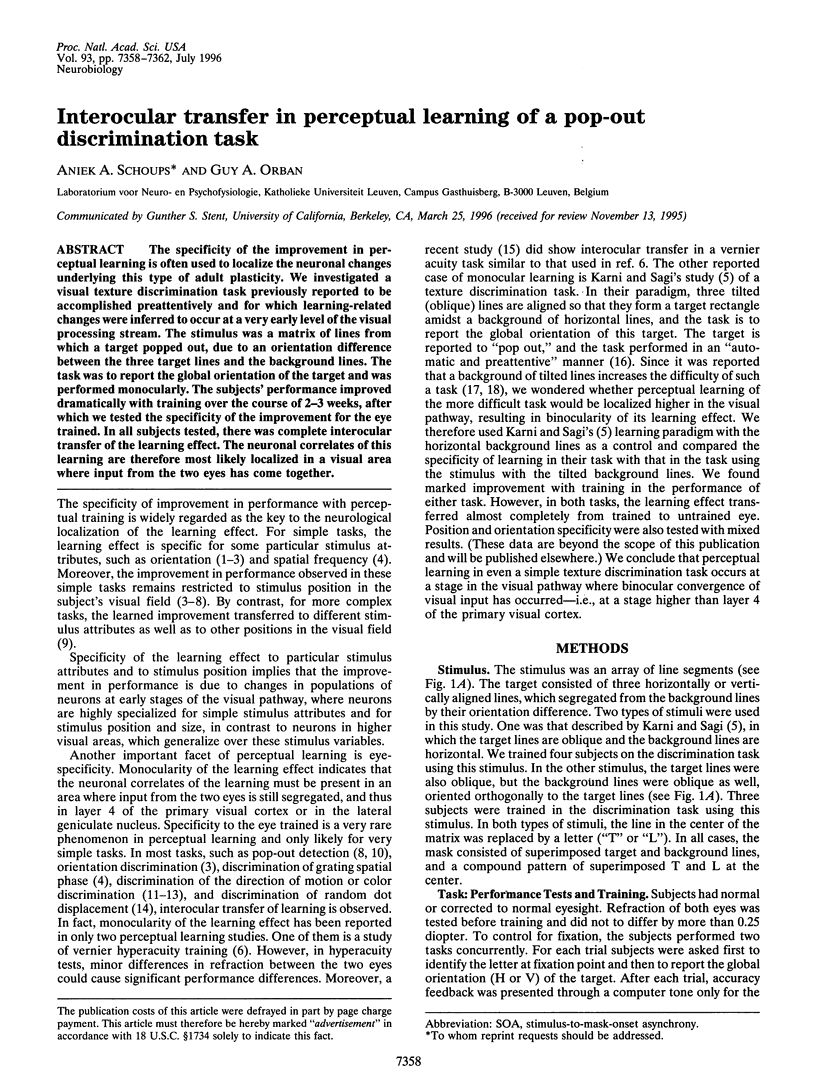
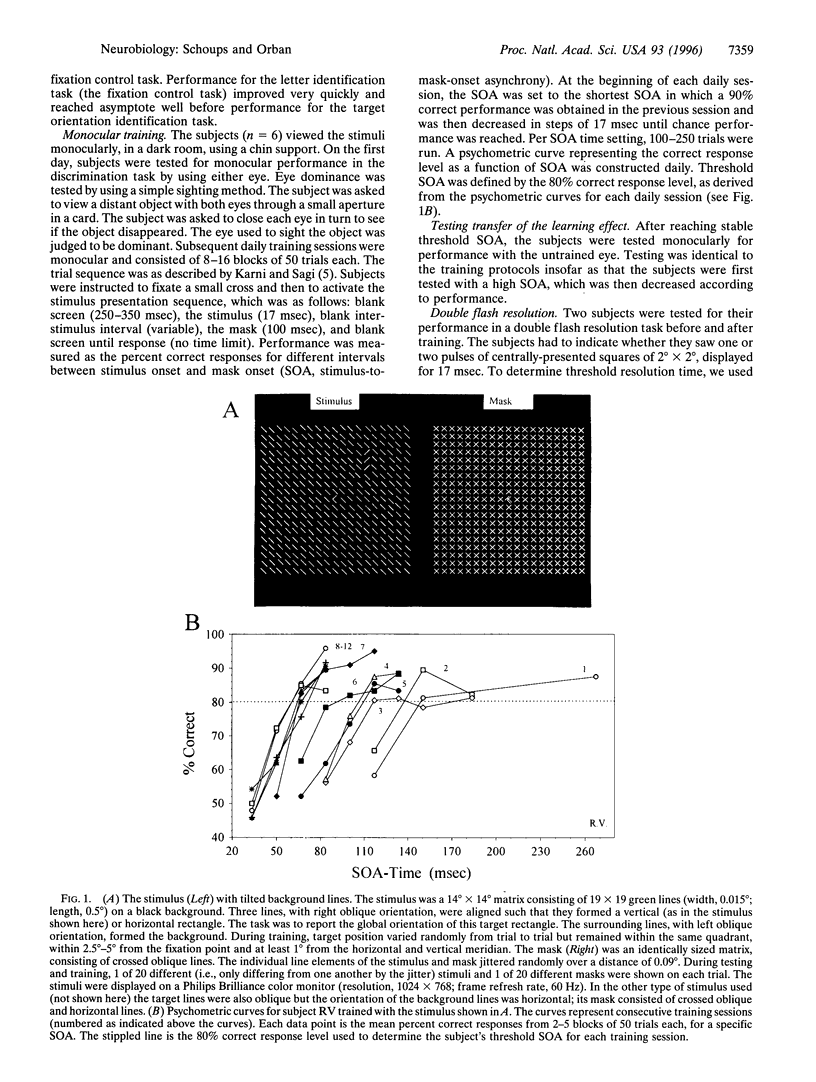
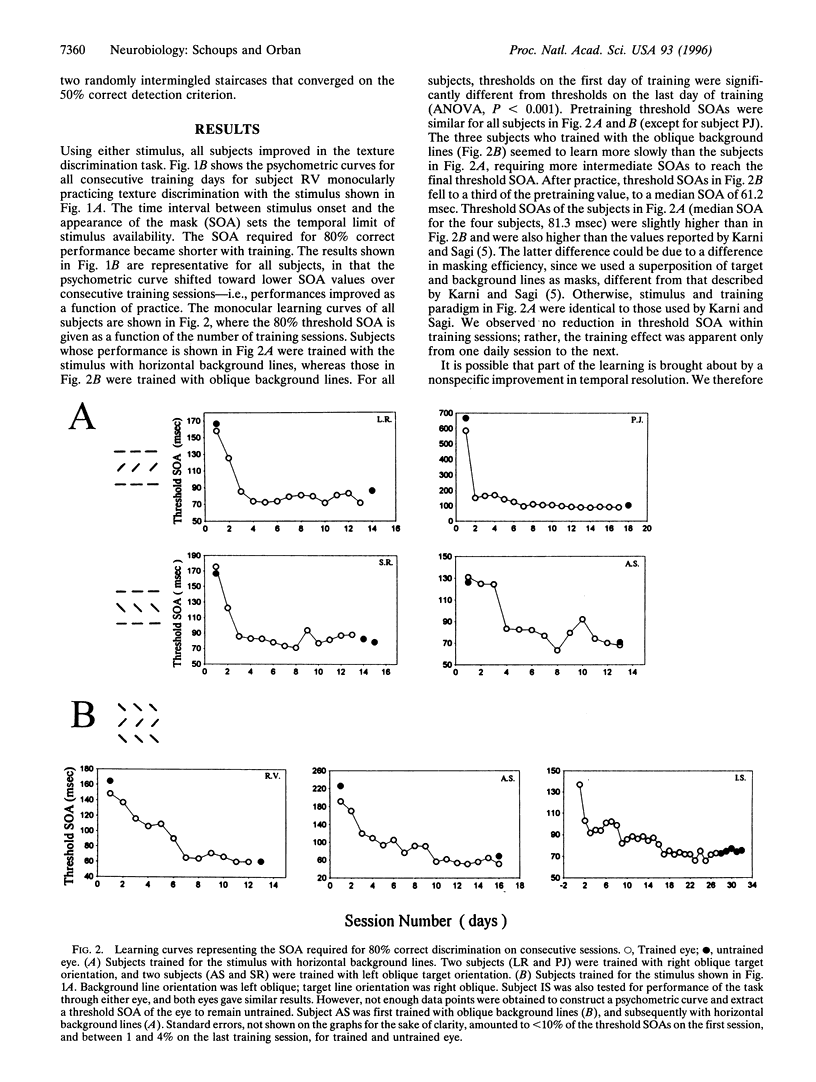
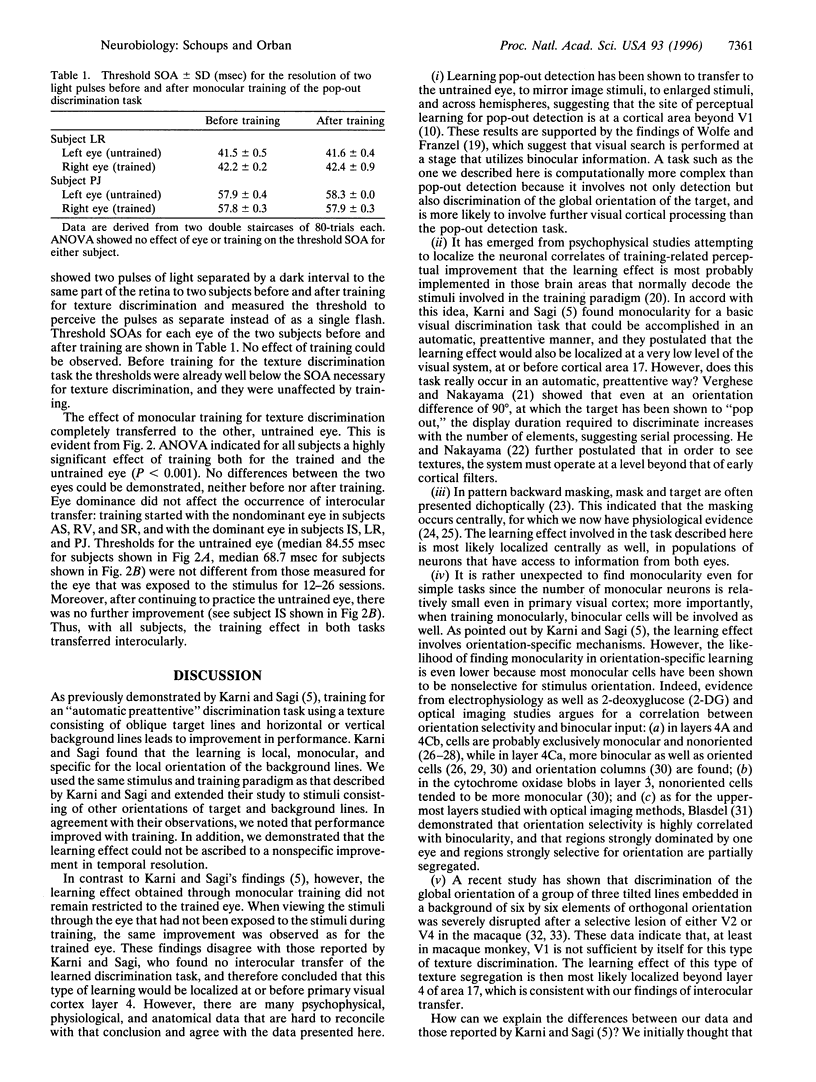
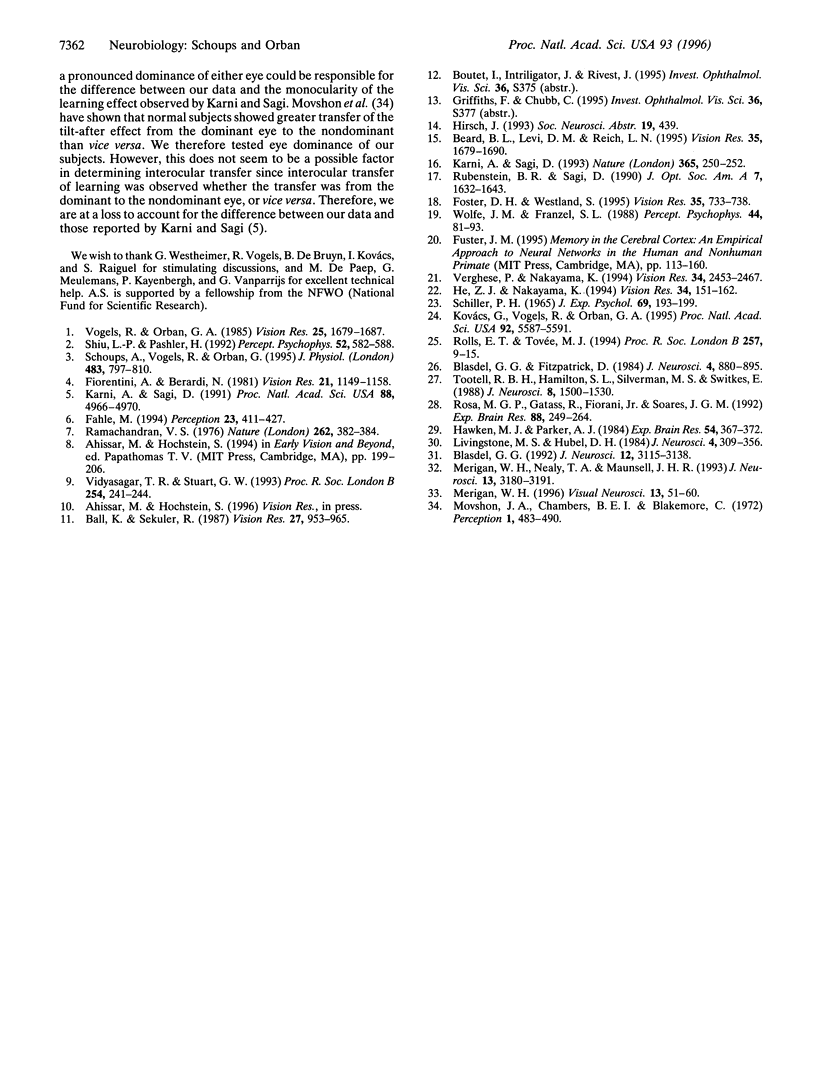
Selected References
These references are in PubMed. This may not be the complete list of references from this article.
- Ball K., Sekuler R. Direction-specific improvement in motion discrimination. Vision Res. 1987;27(6):953–965. doi: 10.1016/0042-6989(87)90011-3. [DOI] [PubMed] [Google Scholar]
- Beard B. L., Levi D. M., Reich L. N. Perceptual learning in parafoveal vision. Vision Res. 1995 Jun;35(12):1679–1690. doi: 10.1016/0042-6989(94)00267-p. [DOI] [PubMed] [Google Scholar]
- Blasdel G. G. Differential imaging of ocular dominance and orientation selectivity in monkey striate cortex. J Neurosci. 1992 Aug;12(8):3115–3138. doi: 10.1523/JNEUROSCI.12-08-03115.1992. [DOI] [PMC free article] [PubMed] [Google Scholar]
- Blasdel G. G., Fitzpatrick D. Physiological organization of layer 4 in macaque striate cortex. J Neurosci. 1984 Mar;4(3):880–895. doi: 10.1523/JNEUROSCI.04-03-00880.1984. [DOI] [PMC free article] [PubMed] [Google Scholar]
- Fahle M. Human pattern recognition: parallel processing and perceptual learning. Perception. 1994;23(4):411–427. doi: 10.1068/p230411. [DOI] [PubMed] [Google Scholar]
- Fiorentini A., Berardi N. Learning in grating waveform discrimination: specificity for orientation and spatial frequency. Vision Res. 1981;21(7):1149–1158. doi: 10.1016/0042-6989(81)90017-1. [DOI] [PubMed] [Google Scholar]
- Foster D. H., Westland S. Orientation contrast vs orientation in line-target detection. Vision Res. 1995 Mar;35(6):733–738. doi: 10.1016/0042-6989(94)00178-o. [DOI] [PubMed] [Google Scholar]
- Hawken M. J., Parker A. J. Contrast sensitivity and orientation selectivity in lamina IV of the striate cortex of Old World monkeys. Exp Brain Res. 1984;54(2):367–372. doi: 10.1007/BF00236238. [DOI] [PubMed] [Google Scholar]
- He Z. J., Nakayama K. Perceiving textures: beyond filtering. Vision Res. 1994 Jan;34(2):151–162. doi: 10.1016/0042-6989(94)90328-x. [DOI] [PubMed] [Google Scholar]
- Karni A., Sagi D. The time course of learning a visual skill. Nature. 1993 Sep 16;365(6443):250–252. doi: 10.1038/365250a0. [DOI] [PubMed] [Google Scholar]
- Karni A., Sagi D. Where practice makes perfect in texture discrimination: evidence for primary visual cortex plasticity. Proc Natl Acad Sci U S A. 1991 Jun 1;88(11):4966–4970. doi: 10.1073/pnas.88.11.4966. [DOI] [PMC free article] [PubMed] [Google Scholar]
- Kovács G., Vogels R., Orban G. A. Cortical correlate of pattern backward masking. Proc Natl Acad Sci U S A. 1995 Jun 6;92(12):5587–5591. doi: 10.1073/pnas.92.12.5587. [DOI] [PMC free article] [PubMed] [Google Scholar]
- Livingstone M. S., Hubel D. H. Anatomy and physiology of a color system in the primate visual cortex. J Neurosci. 1984 Jan;4(1):309–356. doi: 10.1523/JNEUROSCI.04-01-00309.1984. [DOI] [PMC free article] [PubMed] [Google Scholar]
- Merigan W. H. Basic visual capacities and shape discrimination after lesions of extrastriate area V4 in macaques. Vis Neurosci. 1996 Jan-Feb;13(1):51–60. doi: 10.1017/s0952523800007124. [DOI] [PubMed] [Google Scholar]
- Merigan W. H., Nealey T. A., Maunsell J. H. Visual effects of lesions of cortical area V2 in macaques. J Neurosci. 1993 Jul;13(7):3180–3191. doi: 10.1523/JNEUROSCI.13-07-03180.1993. [DOI] [PMC free article] [PubMed] [Google Scholar]
- Movshon J. A., Chambers B. E., Blakemore C. Interocular transfer in normal humans, and those who lack stereopsis. Perception. 1972;1(4):483–490. doi: 10.1068/p010483. [DOI] [PubMed] [Google Scholar]
- Ramachandran V. S. Learning-like phenomena in stereopsis. Nature. 1976 Jul 29;262(5567):382–384. doi: 10.1038/262382a0. [DOI] [PubMed] [Google Scholar]
- Rolls E. T., Tovee M. J. Processing speed in the cerebral cortex and the neurophysiology of visual masking. Proc Biol Sci. 1994 Jul 22;257(1348):9–15. doi: 10.1098/rspb.1994.0087. [DOI] [PubMed] [Google Scholar]
- Rosa M. G., Gattass R., Fiorani M., Jr, Soares J. G. Laminar, columnar and topographic aspects of ocular dominance in the primary visual cortex of Cebus monkeys. Exp Brain Res. 1992;88(2):249–264. doi: 10.1007/BF02259100. [DOI] [PubMed] [Google Scholar]
- Rubenstein B. S., Sagi D. Spatial variability as a limiting factor in texture-discrimination tasks: implications for performance asymmetries. J Opt Soc Am A. 1990 Sep;7(9):1632–1643. doi: 10.1364/josaa.7.001632. [DOI] [PubMed] [Google Scholar]
- SCHILLER P. H. MONOPTIC AND DICHOPTIC VISUAL MASKING BY PATTERNS AND FLASHES. J Exp Psychol. 1965 Feb;69:193–199. doi: 10.1037/h0021574. [DOI] [PubMed] [Google Scholar]
- Schoups A. A., Vogels R., Orban G. A. Human perceptual learning in identifying the oblique orientation: retinotopy, orientation specificity and monocularity. J Physiol. 1995 Mar 15;483(Pt 3):797–810. doi: 10.1113/jphysiol.1995.sp020623. [DOI] [PMC free article] [PubMed] [Google Scholar]
- Shiu L. P., Pashler H. Improvement in line orientation discrimination is retinally local but dependent on cognitive set. Percept Psychophys. 1992 Nov;52(5):582–588. doi: 10.3758/bf03206720. [DOI] [PubMed] [Google Scholar]
- Tootell R. B., Hamilton S. L., Silverman M. S., Switkes E. Functional anatomy of macaque striate cortex. I. Ocular dominance, binocular interactions, and baseline conditions. J Neurosci. 1988 May;8(5):1500–1530. doi: 10.1523/JNEUROSCI.08-05-01500.1988. [DOI] [PMC free article] [PubMed] [Google Scholar]
- Verghese P., Nakayama K. Stimulus discriminability in visual search. Vision Res. 1994 Sep;34(18):2453–2467. doi: 10.1016/0042-6989(94)90289-5. [DOI] [PubMed] [Google Scholar]
- Vidyasagar T. R., Stuart G. W. Perceptual learning in seeing form from motion. Proc Biol Sci. 1993 Dec 22;254(1341):241–244. doi: 10.1098/rspb.1993.0152. [DOI] [PubMed] [Google Scholar]
- Vogels R., Orban G. A. The effect of practice on the oblique effect in line orientation judgments. Vision Res. 1985;25(11):1679–1687. doi: 10.1016/0042-6989(85)90140-3. [DOI] [PubMed] [Google Scholar]
- Wolfe J. M., Franzel S. L. Binocularity and visual search. Percept Psychophys. 1988 Jul;44(1):81–93. doi: 10.3758/bf03207480. [DOI] [PubMed] [Google Scholar]


